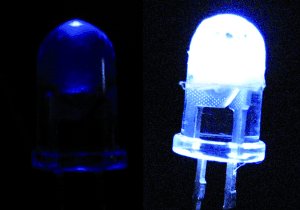Jul 8 2009
Efficient energy transport plays an important role in the development of optoelectonic materials. The true masters of energy transfer via a hierarchical arrangement of different molecules are the photosynthetic mechanisms of plants.

Self-organized systems of biomolecules could also provide a starting point for effective energy transport in future opotoelectronic devices. A team of researchers at the University of Connecticut and the US Air Force Research Laboratory has now successfully used the electrospinning of DNA complexes to produce nanofibers that incorporate two different fluorescing dyes in such a way that energy can efficiently be transferred from one dye to the other. The color of the resulting fluorescence can be controlled by means of the ratio of the two dyes.
As reported in the journal Angewandte Chemie, the team led by Gregory A. Sotzing was thus able to produce nanofibers that emit pure white light—a color that is usually very difficult to achieve in such systems.
In the electrospinning process, a polymer solution is propelled through an electrical field. This results in the formation of nanofibers that are deposited in the form of a mat. When DNA is subjected to such a spinning process in the presence of a surfactant and the desired fluorescence dyes, the result is a network of DNA fibers with organized microstructure containing a very uniform distribution of the dyes.
Both dyes are tuned so that they can enter into a special interaction called fluorescence resonance energy transfer (FRET). In this process, “energy packets” from an excited fluorescence dye (donor) are transferred to a second fluorescence dye (acceptor) with no radiation. The intensity of the FRET depends, among other things, on the distance between the two dyes. The two dyes bind to different locations on the DNA, so that the correct spatial distribution for optimal FRET can be maintained—even at low acceptor concentrations.
Upon irradiation with UV light, the donor absorbs the photons and emits blue light. If acceptor molecules are present at the right distance, some of this energy is not re-emitted; instead it is “passed on” from the donor to the acceptor by means of the radiation-free FRET process. The excited acceptor molecules then emit the energy as fluorescence—in orange. Depending on the ratio of donor and acceptor concentrations, the color of the light changes—from blue through pure white to orange. The color can also be fine-tuned by changing the overall dye density in the matrix. Increasing the dye loads from 1.33 to 10 % can change a “cold” white light to a “warm” tone.
More information: Gregory A. Sotzing, White Luminescence from Multiple-Dye-Doped Electrospun DNA Nanofibers by Fluorescence Resonance Energy Transfer, Angewandte Chemie International Edition 2009, 48, No. 28, 5134-5138, doi: 10.1002/anie.200900885